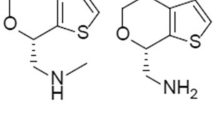Abstract
Purpose: To investigate the bioavailability and bioequivalence of three different formulations of eslicarbazepine acetate (BIA 2-093): 50 mg/mL oral suspension (test 1), 200mg tablets (test 2) and 800mg tablets (reference).
Design, subjects and methods: Single-centre, open-label, randomised, three-way crossover study in 18 healthy subjects. The study consisted of three consecutive periods separated by a washout period of 7 days or more. Each subject received a single dose of eslicarbazepine acetate 800mg on three different occasions: 16mL of oral 50 mg/mL suspension, four 200mg tablets or one 800mg tablet.
Results: Eslicarbazepine acetate was rapidly and extensively metabolised to BIA 2-005. Maximum BIA 2-005 plasma concentrations (Cmax) and area under the plasma concentration-time curve from time 0 to infinity (AUC∞) were, respectively (arithmetic mean ± SD), 18.0 ± 4.6 μg/mL and 325.7 ± 64.9 μg · h/mL for test 1, 16.0 ± 4.0 μg/mL and 304.2 ± 66.0 μg · h/mL for test 2, and 17.0 ± 4.1 μg/mL and 301.1 ± 60.0 μg · h/mL for the reference formulation. Point estimate (PE) and 90% confidence intervals (CIs) for AUC∞ test 1/reference geometric mean ratio were 1.09 and 1.01, 1.15; for Cmax ratio, PE and 90% CI were 1.07 and 0.97, 1.15. When test 2 and the reference formulations were compared, the PE and 90% CI were 0.99 and 0.94, 1.07 for the AUC∞ ratio, and 0.94 and 0.86, 1.02 for the Cmax ratio. Bioequivalence of test versus reference formulations is thus accepted for both AUC∞ and Cmax because the 90% CIs lie within the acceptance range of 0.80–1.25.
Conclusion: The pharmacokinetic profiles of eslicarbazepine acetate oral 50 mg/mL suspension, 200mg tablet and 800mg tablet formulations were essentially similar, and the formulations can be considered bioequivalent.



Similar content being viewed by others
References
Benes J, Parada A, Figueiredo AA, et al. Anticonvulsant and sodium channel-blocking properties of novel 10,11-dihydro-5H-dibenz[b,f]azepine-5-carboxamide derivatives. J Med Chem 1999; 42: 2582–7
Bonifacio MJ, Sheridan RD, Parada A, et al. Interaction of the novel anticonvulsant, BIA 2-093, with voltage-gated sodium channels: comparison with carbamazepine. Epilepsia 2001; 42: 600–8
Almeida L, Falcão A, Maia J, et al. Single-dose and steady-state pharmacokinetics of eslicarbazepine acetate (BIA 2-093) in healthy elderly and young subjects. J Clin Pharmacol. In press.
Almeida L, Soares-da-Silva P. Safety, tolerability and pharmacokinetic profile of BIA 2-093, a novel putative antiepileptic agent, during first administration to humans. Drugs R&D 2003; 4 (5): 269–84
Almeida L, Soares-da-Silva P. Safety, tolerability, and pharmacokinetic profile of BIA 2-093, a novel putative antiepileptic, in a rising multiple-dose study in healthy humans. J Clin Pharmacol 2004; 44: 906–18
Maia J, Vaz-da-Silva M, Almeida L, et al. Effect of food on the pharmacokinetic profile of eslicarbazepine acetate (BIA 2-093). Drugs RD 2005; 6 (4): 201–6
Maia J, Almeida L, Soares-da-Silva P. BIA 2-093 as add-on therapy for refractory partial epilepsy patients [abstract]. Epilepsia 2004; 45 Suppl. 3: 158
Center for Drug Evaluation and Research (CDER). Bioavailability and bioequivalence studies for orally administered products: general considerations. US Department of Health and Human Services, Food and Drug Administration, Rockville (MD): 2000 Oct
Committee for Proprietary Medicinal Products (CPMP). Note for guidance on the investigation of bioavailability and bioequivalence. CPMP/EWP/1401/98, The European Agency for the Evaluation of Medicinal Products (EMEA), London: 2001 Jul
Schuirmann DJ. A comparison of two one-sided tests procedure and the power approach for assessing the equivalence of average bioavailability. J Pharmacokinet Biopharm 1987; 15 (6): 657–80
Acknowledgements
This study was supported by BIAL (Portela & Ca SA).
Author information
Authors and Affiliations
Corresponding author
Rights and permissions
About this article
Cite this article
Fontes-Ribeiro, C., Nunes, T., Falcão, A. et al. Eslicarbazepine Acetate (BIA 2-093). Drugs R D 6, 253–260 (2005). https://doi.org/10.2165/00126839-200506050-00001
Published:
Issue Date:
DOI: https://doi.org/10.2165/00126839-200506050-00001




